Modern puzzle game challenges engage players through innovative mechanics, adaptive difficulty, and social interaction. Trends show a rise in collaborative puzzles and augmented reality features. Player demographics shape experiences, influencing design and engagement strategies. Effective reward systems are crucial for long-term satisfaction and retention.
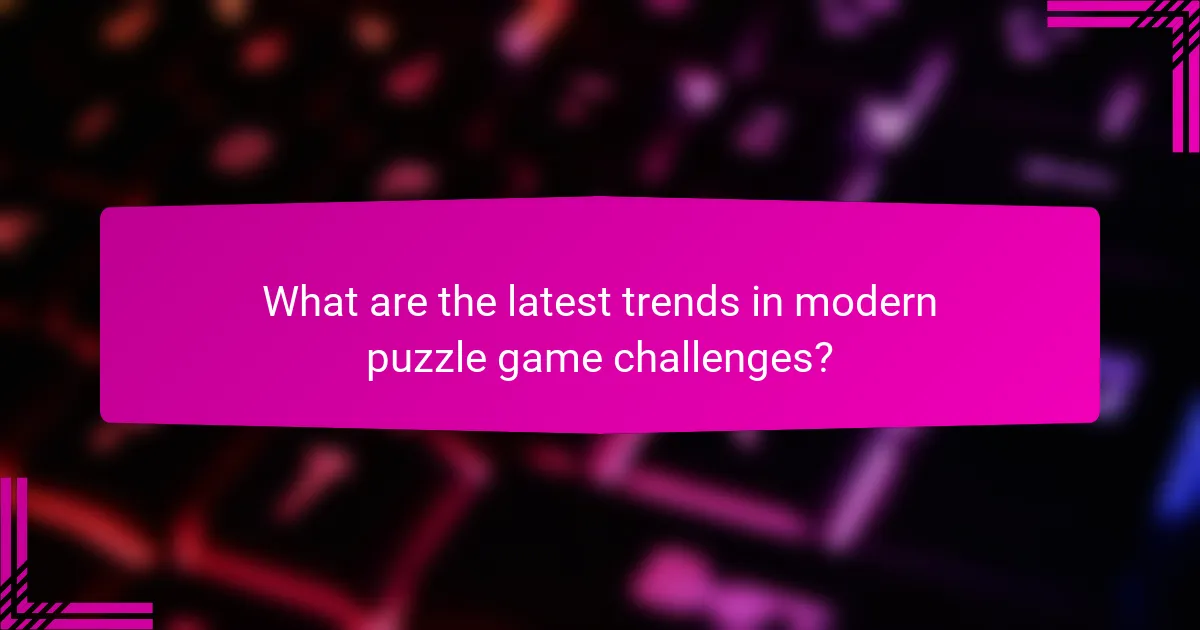
What are the latest trends in modern puzzle game challenges?
Modern puzzle game challenges increasingly focus on innovative mechanics, social interaction, and player rewards. Key trends include adaptive difficulty, which tailors challenges to individual skill levels, enhancing player engagement. Collaborative puzzles are gaining popularity, encouraging teamwork and social connections among players. Additionally, integration of augmented reality enhances immersion and interaction with the game environment. Finally, rewards systems are evolving, emphasizing meaningful incentives that promote long-term player retention and satisfaction.
How do these trends influence player engagement?
Modern puzzle game trends significantly enhance player engagement through innovative gameplay mechanics and social interaction features. For example, time-limited challenges create urgency, motivating players to participate actively. Additionally, collaborative features allow players to team up, fostering a sense of community. These elements not only increase retention rates but also encourage players to share their experiences, further amplifying engagement. Unique rewards tied to these trends incentivize continuous play and exploration, appealing to players’ desire for achievement.
Which platforms are most popular for puzzle game challenges?
Mobile devices, PC, and console platforms dominate puzzle game challenges. Mobile platforms like iOS and Android offer accessibility, while PC platforms provide advanced graphics and community features. Console platforms, such as Nintendo Switch, enhance social play. These platforms engage players through competitive events and reward systems, fostering community interaction.
What role do social interactions play in puzzle gaming?
Social interactions enhance puzzle gaming by fostering community engagement and collaboration among players. They create opportunities for sharing strategies, solving challenges together, and competing in friendly environments. This social aspect can increase player motivation and satisfaction, leading to higher retention rates. Engaging with others also allows players to experience diverse perspectives, enriching their gaming experience.
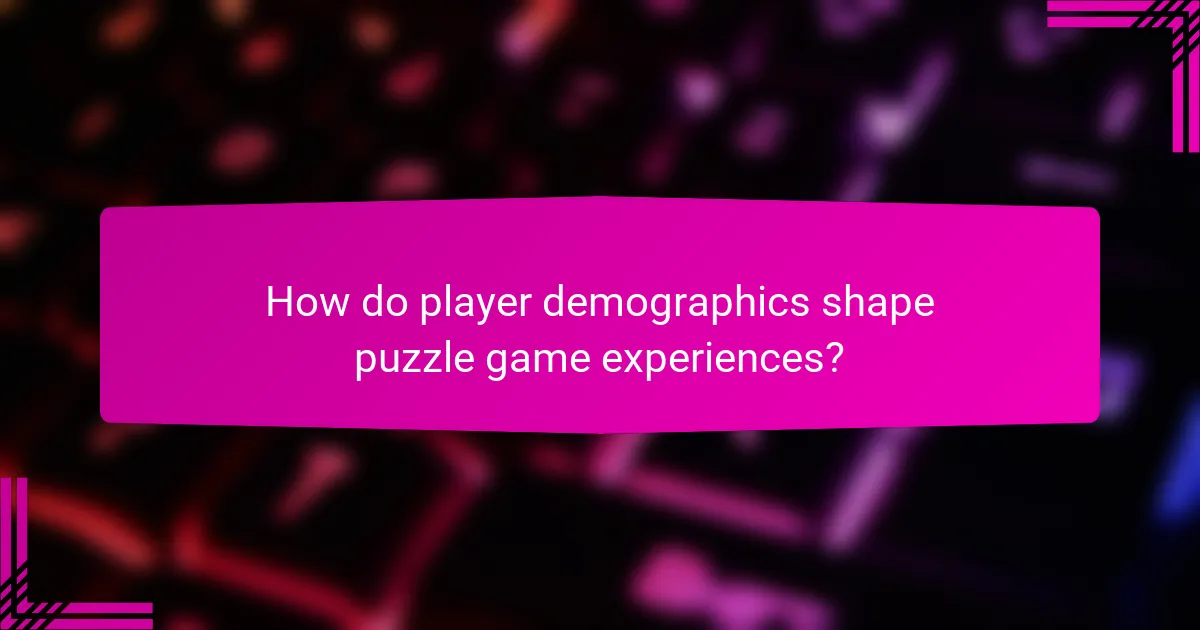
How do player demographics shape puzzle game experiences?
Player demographics significantly influence puzzle game experiences by shaping design, difficulty, and engagement strategies. Younger players often prefer fast-paced, visually stimulating challenges, while older players may favour classic styles with strategic depth. Gender differences also emerge, with women generally enjoying narrative-driven puzzles and men gravitating towards competitive elements.
Game developers analyse demographic data to tailor experiences. For instance, mobile puzzle games frequently incorporate social features to engage younger audiences, while traditional puzzles might focus on single-player modes for older players. This targeted approach enhances player satisfaction and retention.
Additionally, cultural backgrounds impact preferences in themes and narratives. Games that resonate with specific demographics often see higher engagement rates. Understanding these nuances allows developers to create more inclusive and appealing puzzle game experiences.
What are the preferences of casual vs. hardcore players?
Casual players prefer accessible challenges and quick gameplay, while hardcore players seek complex puzzles and deeper engagement. Casual players enjoy short sessions and simple mechanics, focusing on fun and relaxation. Hardcore players invest time in mastering intricate levels, often valuing achievements and competition. Preferences vary significantly in terms of challenge complexity, time commitment, and engagement depth.
How do cultural factors impact puzzle game design?
Cultural factors significantly influence puzzle game design by shaping themes, aesthetics, and player engagement strategies. Designers must consider cultural preferences and values to create relatable experiences. For instance, puzzles that incorporate local folklore or traditions can resonate more deeply with players. Additionally, cultural norms dictate social interactions within games, affecting multiplayer dynamics. Understanding these factors enhances player retention and satisfaction, making cultural awareness a crucial aspect of modern puzzle game development.
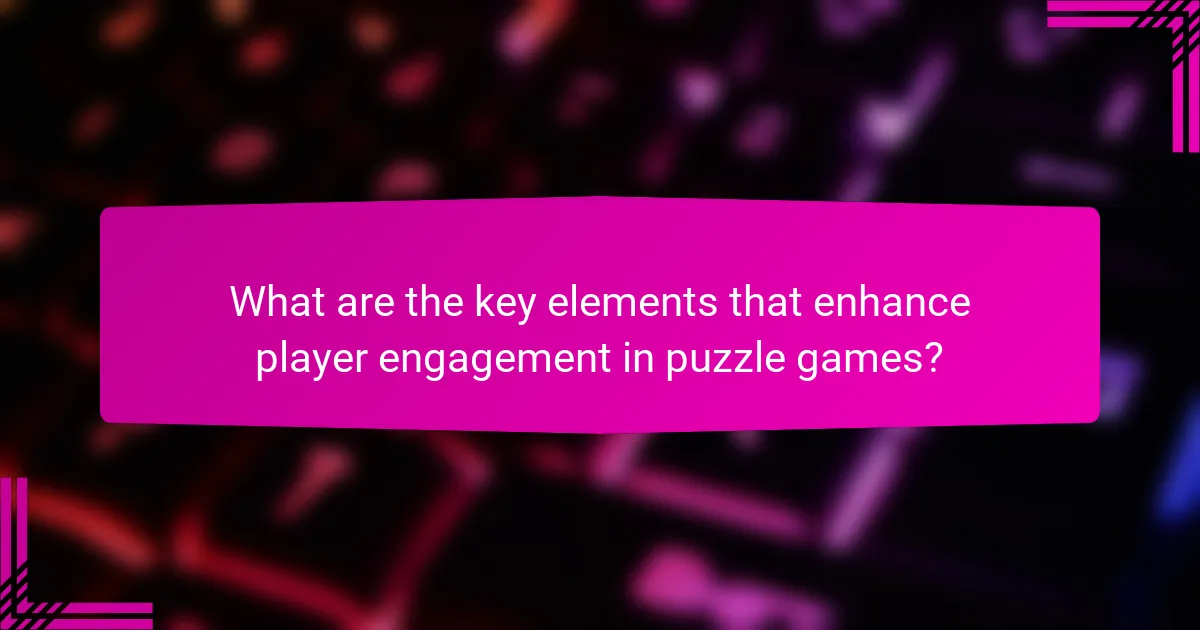
What are the key elements that enhance player engagement in puzzle games?
Key elements that enhance player engagement in puzzle games include challenging gameplay, rewarding progression systems, social interaction, and immersive storytelling. These aspects create a compelling experience that keeps players invested.
Challenging gameplay promotes critical thinking and problem-solving, encouraging players to improve their skills. Rewarding progression systems, such as unlocking new levels or achievements, provide motivation and a sense of accomplishment. Social interaction, through leaderboards or cooperative play, fosters community and competition, enhancing the overall experience. Lastly, immersive storytelling captivates players, drawing them into the game’s world and making the challenges more meaningful.
How do game mechanics affect user retention?
Game mechanics significantly enhance user retention by creating engaging experiences. Key elements like challenge, progression, and rewards keep players motivated. For example, incorporating levels and achievements provides a sense of accomplishment, encouraging continued play. Additionally, social interactions foster community, further enhancing user loyalty. Overall, effective game mechanics are crucial for maintaining player interest and satisfaction.
What types of rewards are most effective in motivating players?
Reward systems that offer immediate gratification, progression incentives, and social recognition are most effective in motivating players. These rewards enhance player engagement and satisfaction.
1. **Immediate Gratification**: Players respond well to instant rewards, such as in-game currency or items, which provide a sense of accomplishment.
2. **Progression Incentives**: Rewards that unlock new levels or features encourage players to continue playing and achieving goals.
3. **Social Recognition**: Leaderboards and achievements foster a competitive spirit, motivating players to enhance their performance for social validation.
4. **Customizable Rewards**: Allowing players to choose their rewards increases their investment in the game experience.
5. **Limited-Time Events**: Time-sensitive rewards create urgency, driving players to participate actively during specific periods.
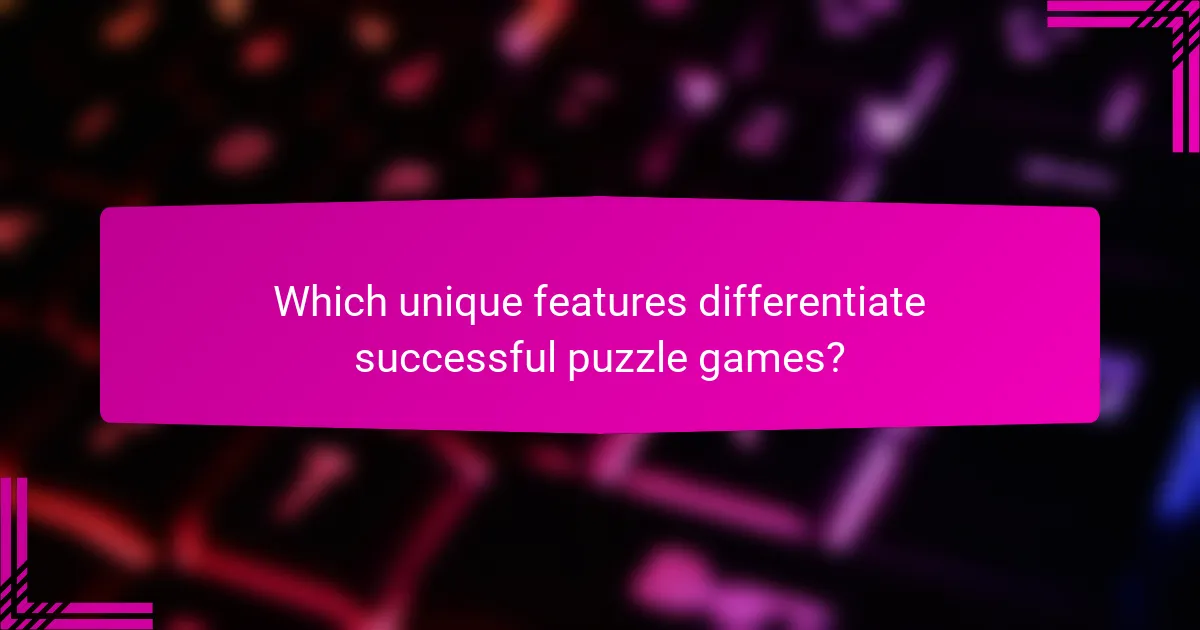
Which unique features differentiate successful puzzle games?
Successful puzzle games stand out due to unique features that enhance player engagement. These include innovative mechanics, immersive storytelling, and adaptive difficulty levels.
Innovative mechanics introduce fresh gameplay elements that challenge players in new ways. Immersive storytelling captivates players, making them emotionally invested in the game. Adaptive difficulty levels ensure that the challenge remains balanced, catering to both casual and experienced players.
Additionally, social features allow players to connect, compete, and collaborate, enhancing the overall experience. Reward systems that provide meaningful incentives also contribute to sustained player interest, encouraging continued play.
How does narrative integration enhance gameplay in puzzles?
Narrative integration enhances gameplay in puzzles by creating immersive experiences that deepen player engagement. It connects challenges to storylines, making each puzzle feel meaningful. Players are more likely to invest time and effort when they see their actions impacting the narrative. This connection can lead to increased satisfaction and motivation to solve puzzles, as the storyline unfolds with each challenge completed. Additionally, narrative elements can introduce unique attributes, such as character development or emotional stakes, which enrich the overall gaming experience.
What innovative technologies are being used in modern puzzle games?
Modern puzzle games utilize innovative technologies like augmented reality, artificial intelligence, and cloud gaming to enhance player engagement. These technologies create immersive experiences, personalize challenges, and enable seamless multiplayer interactions. For instance, augmented reality adds a physical layer to puzzles, while AI adapts difficulty levels based on player performance. Cloud gaming allows access to complex games on various devices without high-end hardware. As a result, these advancements significantly improve gameplay and user satisfaction.
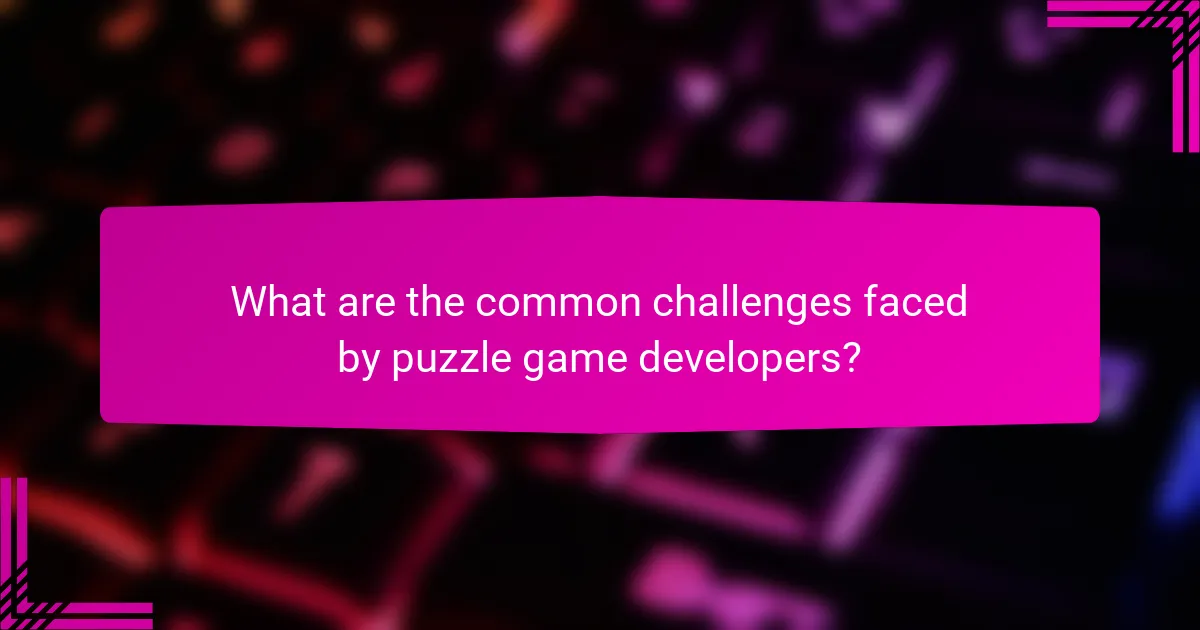
What are the common challenges faced by puzzle game developers?
Puzzle game developers commonly face challenges related to player engagement, monetization, and competition. Maintaining player interest is crucial as trends shift rapidly in the gaming industry. Developers must create innovative gameplay mechanics to stand out in a saturated market. Additionally, balancing monetization strategies with player experience poses a significant hurdle. Ensuring fair rewards while generating revenue can impact player retention and satisfaction.
How do developers balance difficulty and accessibility?
Developers balance difficulty and accessibility by designing challenges that cater to a wide range of player skills. They implement features like adjustable difficulty levels, tutorials, and assistive mechanics to enhance engagement. This approach maintains player interest while ensuring that everyone can enjoy the game experience. For instance, puzzle games often introduce gradual complexity, allowing players to build skills progressively. Balancing these elements fosters an inclusive environment, increasing overall player satisfaction and retention.
What are the implications of monetization strategies on player experience?
Monetization strategies significantly impact player experience by influencing engagement, satisfaction, and retention. Players often react negatively to aggressive monetization, leading to frustration and disengagement. For example, in-app purchases can create a pay-to-win environment, reducing the sense of achievement. Conversely, balanced monetization, like cosmetic upgrades, can enhance enjoyment without disrupting gameplay. Ultimately, the success of a puzzle game hinges on finding a monetization approach that aligns with player expectations and maintains a positive experience.
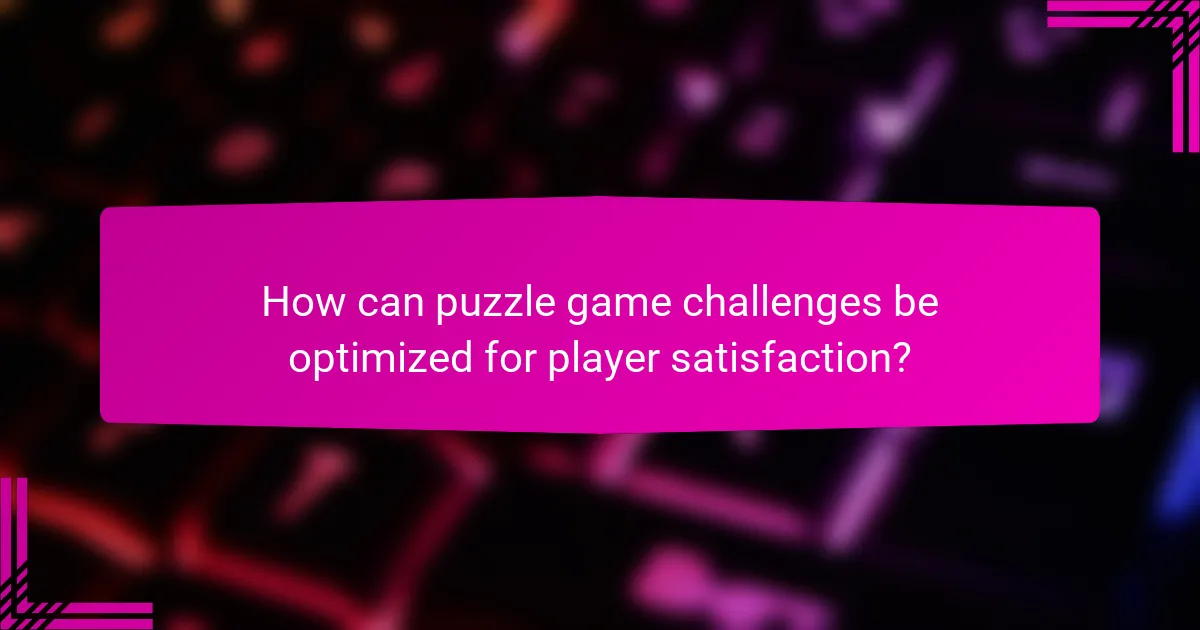
How can puzzle game challenges be optimized for player satisfaction?
To optimize puzzle game challenges for player satisfaction, focus on providing balanced difficulty, engaging narratives, and meaningful rewards. Tailoring challenges to player skill levels enhances engagement and reduces frustration.
Incorporating varied puzzle types keeps gameplay fresh and encourages exploration. Regular updates and community feedback can refine challenges, ensuring they remain relevant and enjoyable.
Reward systems that acknowledge player achievements foster a sense of accomplishment and motivate continued play. Personalized rewards can enhance the gaming experience, making players feel valued.
Tracking player progress and offering adaptive challenges can create a dynamic experience that adjusts to individual preferences, further increasing satisfaction.
What best practices should developers follow for engaging puzzle design?
Developers should prioritize player experience, creativity, and feedback in puzzle design. Engaging puzzles incorporate clear objectives and intuitive mechanics.
1. Design puzzles with escalating difficulty to maintain player interest.
2. Integrate narrative elements to enhance immersion and connection.
3. Utilize player feedback to refine challenges and improve engagement.
4. Implement rewards that recognize achievements, fostering motivation.
What common mistakes do developers make in puzzle game challenges?
Developers often make mistakes in puzzle game challenges by underestimating player engagement, neglecting intuitive design, and failing to balance difficulty. Common errors include creating overly complex mechanics, ignoring feedback loops, and not providing adequate rewards. These pitfalls can lead to frustration and disengagement, ultimately affecting player retention. Addressing these issues can enhance the overall gaming experience and foster a loyal player base.
How can player feedback be effectively incorporated into game updates?
Incorporating player feedback into game updates enhances engagement and satisfaction. Developers should actively collect feedback through surveys, forums, and in-game prompts. Analyzing this data helps identify trends and player preferences. Prioritizing feedback leads to targeted updates that address player concerns, improving gameplay and retention. Engaging with the community fosters a sense of ownership and loyalty among players.
